Today's release of Burp Suite introduces Burp Collaborator. This new feature has the potential to revolutionize web security testing. Over time, Burp Collaborator will enable Burp to detect issues like blind XSS, server-side request forgery, asynchronous code injection, and various as-yet-unclassified vulnerabilities.
In the coming months, we will be adding many exciting new capabilities to Burp, based on the Collaborator technology. See the "Release roadmap" section towards the end of this post for more details.
This blog post looks at:
At its core, conventional web security testing is fairly simple: we send payloads to the target application, and analyze responses to identify security vulnerabilities.

This model is well established and understood, and enables us to identify many kinds of security issues. Much of the work can also be automated with a degree of reliability.
However, the conventional testing model also misses lots of bugs, for example:
Burp Collaborator augments the conventional testing model with a new component, distinct from Burp and the target application. Burp Collaborator can:
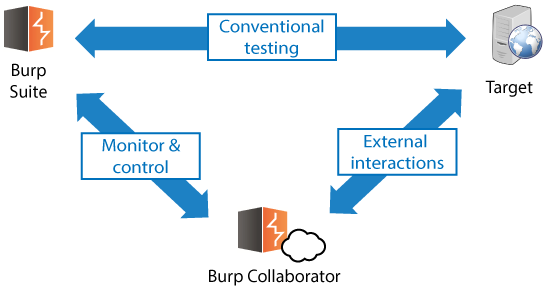
The basic design of Burp Collaborator includes the following features:
External service interaction occurs when a payload submitted to the target application causes it to interact with an arbitrary external domain using some network protocol:

This behavior is sometimes referred to as "server-side request forgery". We prefer the term "external service interaction" because this captures more general behavior: interactions can be triggered using protocols other than HTTP, such as SMB or FTP.
External service interaction can represent a serious vulnerability because it can allow the application server to be used as an attack proxy to target other systems. This may include public third-party systems, internal systems within the same organization, or services available on the local loopback adapter of the application server itself. Depending on the network architecture, this may expose highly vulnerable internal services that are not otherwise accessible to external attackers.
The Burp payload includes a random subdomain of the main Collaborator domain. When an HTTP-based external service interaction occurs, the Collaborator server will typically receive a DNS lookup for this subdomain, followed by an HTTP request. However, it is noteworthy that the DNS lookup alone is sufficient to report an issue. If a payload starting "http://..." causes a DNS-only interaction, then this strongly indicates that outbound HTTP from the server is being blocked at the network layer. In this situation, a follow-up attack could target other systems internal to the organization or running on the server's loopback adapter. For this reason, Burp separately reports any DNS and HTTP interactions that are triggered.
In its issue advisory, Burp reports the in-band request that was made to the application, and the full details of the interactions that occurred with the Collaborator server:


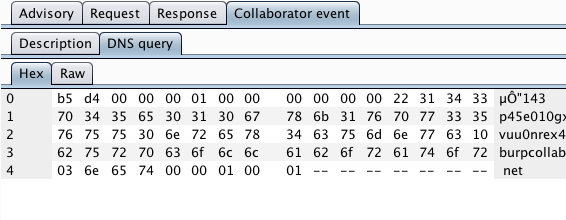
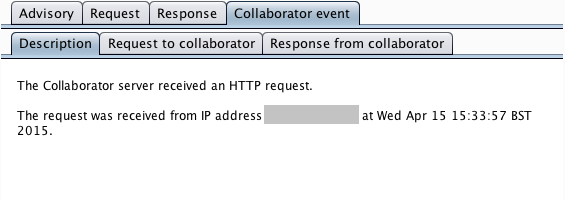

Out-of-band resource load occurs when a payload submitted to the target application causes it to fetch content from an arbitrary external domain using some network protocol, and incorporate that content into its own response to the request that contained the payload:
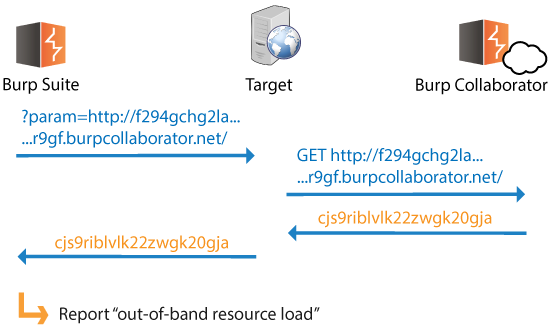
This behavior is sometimes referred to as "remote file include". However, this label has connotations of vulnerabilities like PHP remote script inclusion. We prefer the term "out-of-band resource load" because this captures the more general behavior where content obtained out-of-band is somehow incorporated into the application's own responses. (Server-side execution of content obtained out-of-band is discussed later in this post.)
Out-of-band resource load is a potentially high-risk issue. An attacker can leverage the application as a two-way attack proxy, sending arbitrary payloads to, and retrieving content from, other systems that the application server can interact with. Again, this may include third-party systems or sensitive internal systems that are otherwise inaccessible.
Additionally, the application's processing of out-of-band content exposes some important and non-conventional attack surface. The possible ways of targeting this are described in more detail later in this post.
Burp reports the full details of the interactions that occurred with the Collaborator server, showing how the content returned from the Collaborator is propagated back in the application's in-band response to the user:
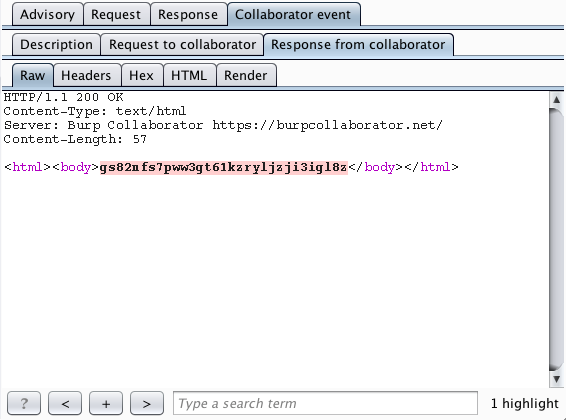
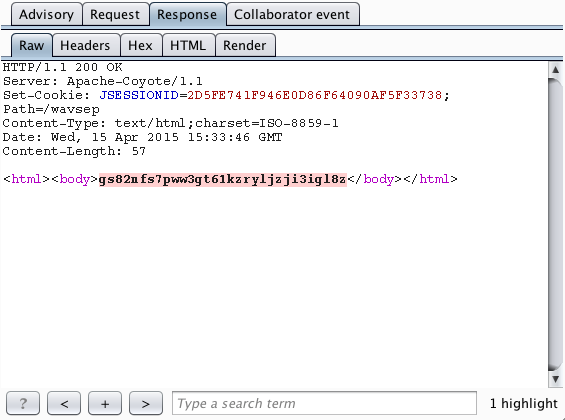
In cases where out-of-band resource load is identified, the most obvious related issue to check for is out-of-band XSS:

Out-of-band XSS doesn't fall under the usual XSS classifications:
Out-of-band versions of some other client-side issues arise in a similar way, including HTTP response header injection, and open redirection.
In cases where a code injection attack cannot trigger any detectable effect in the application's own responses (that is, any difference in response contents or timing), we can often detect the vulnerability by using payloads that trigger an external service interaction when the injection is successful:
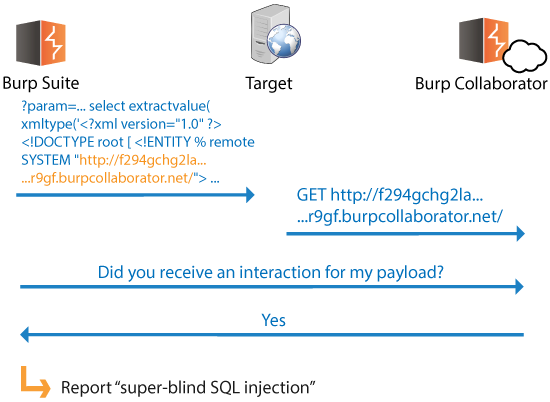
Viable payloads exist for many categories of injection vulnerabilities, including SQL injection, XXE injection, OS command injection, etc. With these payloads, Burp does not need to observe any effect in the application's own responses, and successful injection can be detected solely through the fact that the external interaction occurred. Note also that in this situation, only a DNS interaction is needed to confirm the injection. Since outbound DNS is almost always permitted because servers need to use it, network-layer filters are unlikely to hinder detection.
When any type of external service interaction is identified, we can use the Collaborator server's responses to deliver conventional input-based payloads back to the application. Depending on how the application processes the Collaborator's responses, potentially any input-based vulnerability could exist, including SQL injection and server-side code execution:

Vulnerabilities like this might be surprisingly common because they are not thoroughly tested for at present.
In addition to the out-of-band injection bugs described in the previous section, there is the potential for stored out-of-band attacks in any situation where the target application processes data that it receives in responses from the Collaborator server.
Detecting stored out-of-band resource load is straightforward:

Based on the above behavior, we can also test for stored out-of-band XSS:
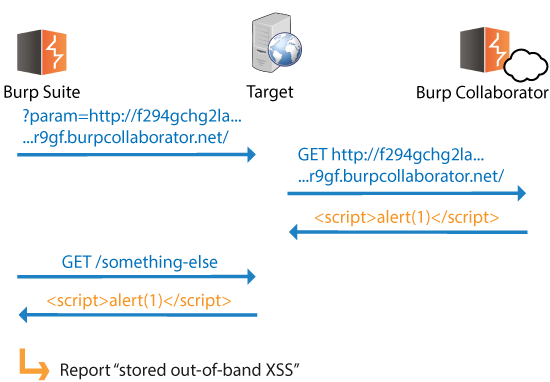
Whenever we discover stored out-of-band resource load, we are able to link an entry point and a retrieval point within the application. We know that the application is storing and processing data between the two locations, so we can check for stored out-of-band versions of any type of input-based bug:

We already described how we can detect "super-blind" injection bugs using payloads that trigger an external service interaction when the injection is successful. We can also detect cases where these (or other) payloads are stored and processed later in an unsafe way. Deferred interactions with the Collaborator server enable us to report blind stored versions of many input-based bugs.
For example, blind stored XSS arises when the result of a stored XSS attack cannot be detected from the tester's perspective, because the tester does not have access to the area of the application where the stored attack executes. We can detect these issues by submitting stored XSS payloads that will trigger an interaction with the Collaborator server when the attack later executes:
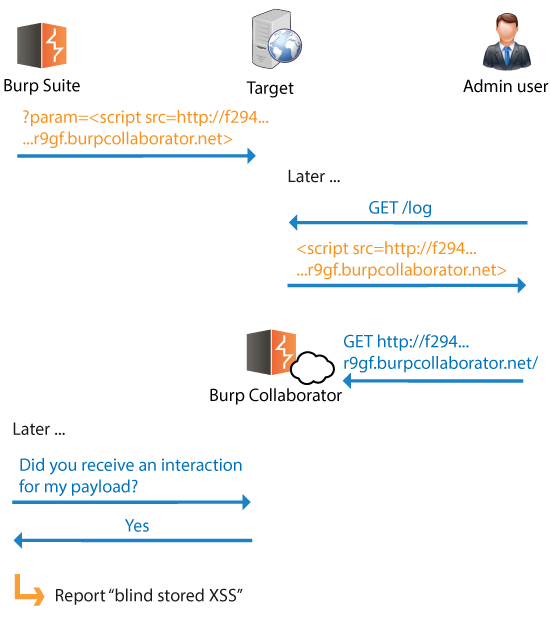
In this example, when an application administrator visits the relevant protected page, the stored attack executes, and Burp can confirm this via the Collaborator server. Further, the HTTP Referer header in the administrator's incoming request to the Collaborator lets us identify the location of the XSS retrieval page, which we cannot directly see ourselves.
In general, any Collaborator-related payload that Burp sends to the target application might cause deferred interactions with the Collaborator server. This can happen in two main ways:
When Burp polls the Collaborator server to retrieve details of any interactions that were triggered by a given test, it will also receive details of any deferred interactions that have resulted from its earlier tests. Burp can then report the relevant issues to the user retrospectively.
Because every Collaborator payload that Burp sends to the target includes a unique, one-time random identifier, when a deferred interaction occurs, Burp can use the identifier to pinpoint exactly where the payload originated, including the original request, the insertion point and the full payload.
Imagine this: A day after you finish your test, you fire up Burp Suite and open the same project. Burp polls the Collaborator and reports some deferred-interaction issues, with all the usual details. You call up the client and tell them about all their blind stored XSS ...
We have focused on vulnerabilities involving DNS and HTTP interactions between the target application and Burp Collaborator. In fact, we can use payloads to trigger Collaborator interactions using various other protocols. For example, we can potentially:
Some of the application behavior we have described is relatively rare, for example:
Other behavior is relatively common, for example:
It seems fair to say that the cases where the relevant behavior exists are relatively untested, even by skilled attackers:
Hence, we may reasonably conclude that where the relevant behavior exists, there is lots of low hanging fruit to be found. Anecdotal evidence from skilled bug bounty hunters supports this conclusion. (Sorry guys, Burp will soon open up these bugs to the masses!)
In the hands of a well-designed automated scanner, the Collaborator concept is incredibly powerful. There is also potential for some great manual tools that leverage the Collaborator's capabilities. These tools would let users manually verify and exploit issues that Burp Scanner has reported (for example, performing custom data exfiltration via super-blind SQL injection), and also do their own targeted testing of relevant attack surface.
Two key manual tools are planned:
This will include the following components
Used in conjunction with Burp Repeater, the Collaborator client will give you real-time three-way interaction between Burp, the target application, and the Collaborator server, all under full manual control.
This will provide a new Intruder attack option to use out-of-band payload delivery when an external service interaction has been identified. With the option enabled, Burp will send a unique Collaborator URL as the in-band payload to the target application. When the target performs the external interaction, the Collaborator server will return the actual configured payload to the target.
At this point, you may be forgiven for asking "Does this mean that the Collaborator server holds details of all the vulnerabilities that are found using it? What's to stop anyone else fetching the details of my issues?".
In fact, you're not just forgiven for asking this: we'd be disappointed if you didn't. We've spent a lot of time ourselves thinking about these questions.
In most cases, when a vulnerability is found, the Collaborator server will not receive enough information to identify the vulnerability. It does not see the HTTP request that was sent from Burp to the target application. In a typical case, it will record that an interaction was received from somewhere, including a random identifier that was generated by Burp. Occasionally, the Collaborator server will receive some application-specific data: for example, the contents of an email generated through a user registration form.
The Collaborator functionality is designed so that only the instance of Burp that generated a given payload is able to retrieve the details of any interactions that result from that payload. This requirement is implemented as follows:
Further to this mechanism, the following precautions are also implemented in the Collaborator server to protect against unauthorized access to its data:
Users who remain paranoid about any data passing through the shared Burp Collaborator server have two alternative options. If you wish, you can completely disable use of the Collaborator feature within Burp. Even better, you can choose to run your own private Collaborator server:

Anyone with a Burp Suite Professional license can run their own instance of the Collaborator server. To do this fully effectively, you will need a host server, a dedicated domain name, and a valid CA-signed wildcard SSL certificate. Private Collaborator servers without a suitable domain name or SSL certificate will be able to support some, but not all, of the Collaborator-related capabilities within Burp.
You can protect your private Collaborator instance at the network layer: you can configure different network interfaces to receive interactions and answer polling requests, and you can apply whatever IP restrictions you want, given the locations of your targets and testers. The option to use a private Collaborator server is likely to appeal to penetration testing firms and in-house security teams. It can also enable individual testers to deploy a Collaborator instance when testing on private closed networks with no Internet access.
See the documentation on deploying a private Collaborator server for more details.
Today's Burp Suite release includes the following elements:
In the coming months, we will deliver some of the other capabilities described in this post, including:
Read the full Burp Collaborator documentation
Have fun!